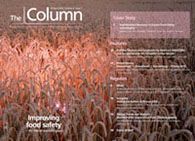Sophisticated Measures to Ensure Food Safety and Integrity
Some of the threats to food safety and the measures in place for protection are discussed
In February this year China announced intensified efforts to ensure safer food, after melamine-tainted milk products from the 2008 scandal in which six babies died and 300 000 babies fell ill, re-emerged in several stores around the country.
This tragedy brought the issue of food safety under the world spotlight. The World Health Organization (WHO) has stated that foodborne diseases and threats to food safety constitute a growing public health problem. Unsafe food is the cause of many acute and lifelong diseases, ranging from diarrhoeal diseases to various forms of cancer. WHO estimates that foodborne and waterborne diarrhoeal diseases taken together kill about 2.2 million people annually, 1.9 million of them children.
Many world governments, particularly those in developed countries, have established dedicated bodies to develop, monitor and enforce food safety directives and regulations.
The EU parliament is informed on food safety matters by the European Food Safety Authority (EFSA). In the US, the Food and Drug Administration (FDA) publishes the Stephen Harrison and Katrin Åkerlindh, Linde AG, Pullach, Germany. Food Code, a model set of guidelines and procedures that assists food control jurisdictions by providing a scientifically sound technical and legal basis for regulating the retail and food service industries, including restaurants, grocery stores and institutional foodservice providers such as nursing homes.
In recent years, the Chinese government attempted to consolidate food regulation with the formation of the State Food and Drug Administration of China in 2003 and, following the 2008 tainted milk scandal, officials have come under intense public and international pressure to solve food safety problems. However, it appears that these regulations are not well known by the trade. Labels used for “green” food, “organic” food and “pollution-free” food are not well recognized by traders and many are unclear about their meaning.

Analytical Challenges in Measuring Migration from Food Contact Materials
November 2nd 2015Food contact materials contain low molecular weight additives and processing aids which can migrate into foods leading to trace levels of contamination. Food safety is ensured through regulations, comprising compositional controls and migration limits, which present a significant analytical challenge to the food industry to ensure compliance and demonstrate due diligence. Of the various analytical approaches, LC-MS/MS has proved to be an essential tool in monitoring migration of target compounds into foods, and more sophisticated approaches such as LC-high resolution MS (Orbitrap) are being increasingly used for untargeted analysis to monitor non-intentionally added substances. This podcast will provide an overview to this area, illustrated with various applications showing current approaches being employed.









